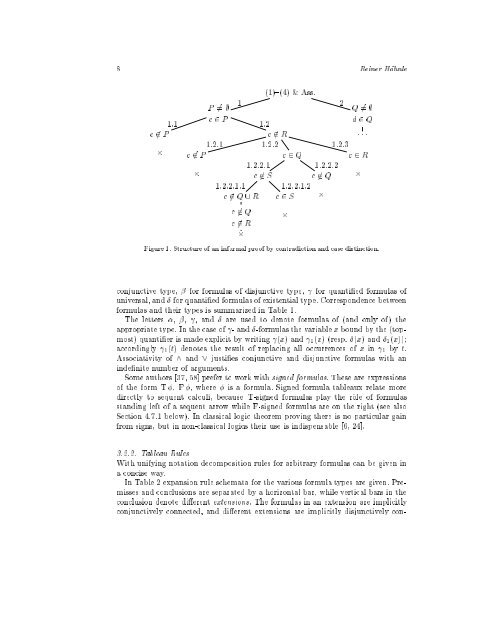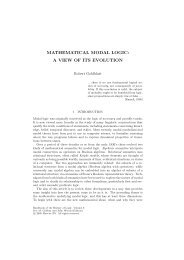You also want an ePaper? Increase the reach of your titles
YUMPU automatically turns print PDFs into web optimized ePapers that Google loves.
8 Reiner Hahnle1.1c 62 PP 6= ;c 2 P1.2.1c 62 P11.2.2.1.1c 62 Q [ Rc 62 Qc 62 R(1){(4) & Ass.1.2c 62 R1.2.2c 2 Q1.2.2.1c 62 S1.2.3c 2 R1.2.2.2c 62 Q 1.2.2.1.2c 2 S 2Q 6= ;d 2 QFigure 1. Structure of an informal proof by contradiction and case distinction.conjunctive type, for formulas of disjunctive type, for quantied formulas ofuniversal, and for quantied formulas of existential type. Correspondence betweenformulas and their types is summarized in Table 1.The letters , , , and are used to denote formulas of (and only of) theappropriate type. In the case of - and -formulas the variable x bound by the (topmost)quantier is made explicit by writing (x) and 1 (x) (resp. (x) and 1 (x));accordingly 1 (t) denotes the result of replacing all occurrences of x in 1 by t.Associativity of^ and _ justies conjunctive and disjunctive formulas with anindenite number of arguments.Some authors [37, 58] prefer to work with signed formulas. These are expressionsof the form T , F , where is a formula. Signed formula tableaux relate moredirectly to sequent calculi, because T-signed formulas play the r^ole of formulasstanding left of a sequent arrow while F-signed formulas are on the right (see alsoSection 4.7.1 below). In classical logic theorem proving there is no particular gainfrom signs, but in non-classical logics their use is indispensable [6, 24].3.2.2. <strong>Tableau</strong> RulesWith unifying notation decomposition rules for arbitrary formulas can be given ina concise way.In Table 2 expansion rule schemata for the various formula types are given. Premissesand conclusions are separated by a horizontal bar, while vertical bars in theconclusion denote dierent extensions. The formulas in an extension are implicitlyconjunctively connected, and dierent extensions are implicitly disjunctively con-
















